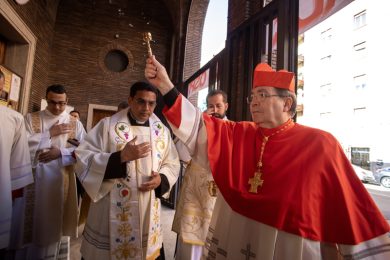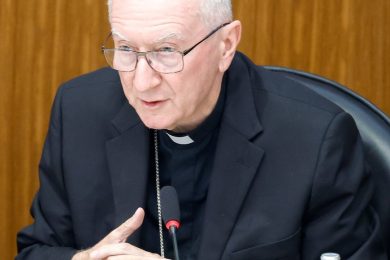On Oct. 9, Bishop Donald Kettler adopted a new cohabitation policy for the Diocese of St. Cloud. The policy, for couples desiring the sacrament of marriage, includes a welcome and a challenge.

Cohabitation is defined as a man and woman living together without being married, and it has become a staple in our society. Cohabitation is ingrained in our practice and sewn into the media we consume. It is increasingly difficult to find examples of engaged couples who are living separately.
Even practicing Catholics whose children are living together feel that there is nothing they can do or say to change it. I’ve heard many parents say something like, “Oh well, they’re adults. They make their own decisions now. There’s nothing we can say.” Most young people (and many others) view cohabitation as a common step taken on their way toward marriage. Or many consider it a convenient method of “testing” their relationship to ensure they are compatible as a couple before they go any further. For others, it is simply a way to be in a relationship without any “strings attached.” Regardless of their reasoning, cohabitation has become a norm for our culture.
In response to this practice, Bishop Kettler has adopted a new diocesan policy to help engaged couples who are living together approach the sacrament of matrimony. The new policy includes a set of guidelines for priests and deacons to discuss the blessings of the sacrament with the engaged couple and illustrate how cohabitation can inhibit those blessings. Bishop Kettler recognizes and understands that many of the engaged couples approaching the Church for the sacrament of matrimony are currently living together. So, how does the Church respond to this challenge with pastoral care and uncompromising belief in the grace offered through the sacrament?
Along with the policy itself, Bishop Kettler has included “talking points” to assist the priests and deacons in preparing the couples for marriage. These talking points offer a very positive approach to discussing the subject of cohabitation. The talking points emphasize the wonderful benefits of a strong marriage and list the great practices that strengthen marriages, like praying together, good communication, making time together as a couple, forgiveness, service to others, and practicing natural family planning.
We, of course, are thrilled when engaged couples want to be married in the Catholic Church. The Diocese of St. Cloud has so many amazing priests and deacons who do incredible work preparing couples for the sacrament of matrimony. Bishop Kettler’s desire is to help and encourage them in their work and give them a pastoral, prayerful and clear process to deal with the difficult topic of cohabitation. How priests and deacons respond to the topic of cohabitation can make an enormous difference. This policy allows the priest or deacon to both welcome the couple and challenge them in a loving way.
Patrick Flynn is the diocesan director of the Office of Marriage and Family.
Cohabitation Policy
1. The first meeting with the couple should be a general introduction without a discussion about cohabitation. That discussion should occur at a subsequent meeting with the priest or deacon.
2. The emphasis of the cohabitation meeting should be the blessings and opportunities of a good marriage.
3. The guidelines for the discussion about cohabitation are included in the Pre-Marriage Talking Points and accompanying materials.
4. The couple should be asked to live apart or with some other appropriate accommodation. They should be given opportunity, before a subsequent meeting with the priest or deacon, to discuss this issue privately with prayer.
5. Should a couple determine that they cannot discontinue cohabitation, the priest determines the next steps. Moving toward a Catholic marriage ceremony remains a possibility. The fact that the couple may choose to continue cohabitating should not necessarily become the basis for denying them the sacrament of matrimony. Also, the ritual used is to be determined by the priest.
6. There are three goals for these discussions:
A. The couple would understand the value of chastity.
B. The couple and the pastor, priest or deacon would have opportunities to listen to each other.
C. A relationship would be established between the priest or deacon and the couple.
Promulgated on Oct. 9, 2020, by Bishop Donald Kettler























Pat,
I am a Confirmation Sponsor for my grandson. What is the teaching, conversation around that going backwards in age to use this new information to create an awareness for that age of 16? And what is the teaching you are creating on this from the beginning for parents, grandparents and others who want to add this new way of addressing from the beginning? Confirmation age is late. Also, does this vary from Diocese to Diocese? Is there a master plan?